Puno, Peru – Some thoughts looking back at our last day in Puno – for a small, rural city, it’s very clean. There’s definitely a bit of dirt and grime around, but there’s simply no litter – and I noted that people are very careful about depositing their garbage in trash receptacles around the city to be picked up. The city has daily garbage pickup, and the garbage trucks come down the street ringing a bell reminiscent of a Good Humor truck. They stop at each corner, and people run their garbage out to the truck and toss it in themselves. The garbage collectors don’t seem to do anything but ride the truck and greet people, along with emptying the public trashcans – private cans are up to the individual owners to empty into the truck. There’s no dog poop on the streets either, people clean up after their dogs, and even the dogs that roam the streets on their own, someone tends to clean up after them.
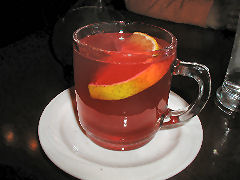 We tried this great drink called the Huajsapata, named after the local lookout hill. It’s a warm mulled wine or pisco, flavored with grenadine, orange bitters, spices, and a bit of orange peel. The pisco version is far superior to the wine – which is probably because Peruvian pisco is far superior to Peruvian wine… Restaurants are open early – dinner hour starts around five and only goes until ten – after that, forget getting anything to eat other than maybe pizza. Bars don’t stay open much later, maybe midnight or one, other than a few run specifically for tourists. In fact, a lot of things are done just for tourists. For a small town in the mountains, as best I could tell, its industries are tourism and fishing, in that order. Dining in the center of Puno, even at the diviest looking spot, costs more than eating out at a really nice spot in Buenos Aires.
We tried this great drink called the Huajsapata, named after the local lookout hill. It’s a warm mulled wine or pisco, flavored with grenadine, orange bitters, spices, and a bit of orange peel. The pisco version is far superior to the wine – which is probably because Peruvian pisco is far superior to Peruvian wine… Restaurants are open early – dinner hour starts around five and only goes until ten – after that, forget getting anything to eat other than maybe pizza. Bars don’t stay open much later, maybe midnight or one, other than a few run specifically for tourists. In fact, a lot of things are done just for tourists. For a small town in the mountains, as best I could tell, its industries are tourism and fishing, in that order. Dining in the center of Puno, even at the diviest looking spot, costs more than eating out at a really nice spot in Buenos Aires.
Did I ever mention that it’s nearly 4,000 meters (13,000 feet) in altitude? Altitude sickness is prevalent, and as mentioned before, they’re ready for it with coca tea, coca candies, and you can buy dried coca leaves at the lowest end of the central market. Every hotel has an oxygen tank on standby… in fact, on our third night there, I awoke with a pounding headache… Henry went down to get me some more tea from the pot in the lobby, and came back with the night attendant with a tank of oxygen as well. After ten minutes of breathing from it, and taking the tea, nothing… which points to one thing – not every headache, joint ache, pain, or nausea that you might have in high altitude is altitude related. Mine seems to have come down to that I’d followed the local recommendation of not drinking caffeine or alcohol your first couple of days there – might not be the best idea for everyone. It suddenly occurred to me that I might be having a bit of a caffeine withdrawal, one cup of coffee and my headache completely cleared.
Keep in mind too, that altitude has an effect on sunlight and temperature – sunblock, sunblock, and hat… trust me. And dress in layers – a t-shirt, a sweater, a light jacket, then you can remove and put them on as needed – temperatures might bounce between 40 something and 80 something over the course of just a few hours. Hotels don’t have heating (no one does here) or air conditioning, not that you’d really ever need the latter – they’ll have plenty of blankets. But have something warm to sleep in. Puno only has two seasons – dry and wet – this is wet season, so it rains at least an hour or two a day, every day, usually twice, not hard, but steady. Make sure that jacket is waterproof, or bring a simple plastic poncho to throw over it all.
Everyone in town, pretty much, speaks either Aymara, Quechua, or both, as well as some level of Spanish. It’s worth your time to learn a few words, even just a basic “hello, how are you?” greeting. It breaks the ice, brings a smile to the faces. I have to say, once again in regard to guide books as I mentioned in my last post, some things aren’t what they seem. The Lonely Planet Quechua Phrasebook, touted as the only English language Quechua guide, first of all isn’t, and second of all, despite the claim that it’s written by a native speaker, is simply wrong, on a massive scale. Most of it turns out to be Spanish-ized Quechua (like “wuenos dias” for “good day” – which is just someone who doesn’t speak Spanish well), or misuse of words – for example, there is simply no Quechua word for “thank you” the way we use it, the book uses the word that’s used for giving thanks to the gods and turns it into an interpersonal statement, which brought peels of laughter from the Quechua friend who taught me some basic phrases. Flipping through the book with her was an exercise in making corrections more than learning anything. Even the pronunciation guide for the letters turned out to be wrong for some of them!
Our last day in Puno, the 4th, dawned bright and early with a private tour to a nearby Aymara village, Chucuito. Our guide, a local university student filled with ideas about the world – amazing some of the things they teach – did you know that there’s never been a black champion athlete in the United States because we still have slavery and blacks are not allowed to do things like compete in professional athletics…? No wonder there’s the antagonism towards our country that exists in some places – this is what they’re teaching at public schools and universities, or at least in Puno, Peru… Our guide plans to be a physicist… the first physicist of color in the world, because he’s been told there has never been one – other than Asians.
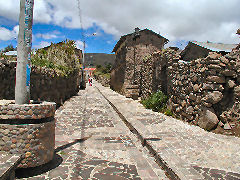
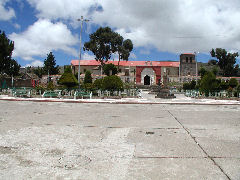
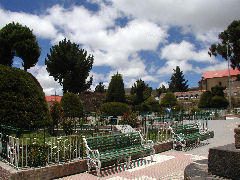
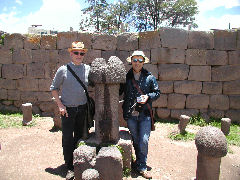
The village was an interesting, sleepy sort of wander. It’s quite pretty, a mix of older Aymara architecture and a lot of colonial domination since that time. More topiary in the public squares. A couple of mildly interesting churches. Most people come to Chucuito for one thing in particular, the Temple of Fertility – an ancient spot that’s part of the “mystic tours” that folks into that sort of thing take – and their were a few around doing their best to absorb whatever energies they thought they could. The “garden” is a large walled enclosure filled with small stone penises… yes, rock-hard dildos, well, actually rock. They range from small to rather large, some pointed up, some down, fairly anatomically correct, especially the largest ones. Women come and sit on them to make themselves fertile… The men stand around and absorb energy and try not to look embarrassed. Plus, there are a couple of spots with hand impressions carved into the stone where the men are supposed to place their hands and draw (or add?) energy from the field. Local children offer tours where they explain the whole thing, straight-faced, for a few soles…
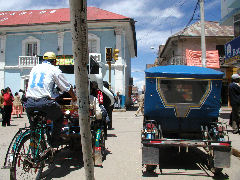 Lunchtime, and back in Puno, we took a bici, the local bicycle cabs, out to Consuela’s house (if you’re ever headed to Puno, contact me, I’ll give you the info) for a bit of local cooking. I’d actually have loved to just spend the morning with her learning to cook the dishes, but Henry was having none of that, so we toured, and, of course, I got to hug a giant stone penis, so I guess I can miss out on a couple of recipes. Carlos, who we’d met the day before, never showed up with his friends, which I think pissed Consuela off considerably – not that I blame her, if you’ve cooked up a special lunch for five, and only two show, and the host of the group doesn’t… but she took it in stride, chatted with us, we met her family, and we sampled a few local specialties – her own versions – the local triangular bread puffs, ají de huacatay, garlic sauce, cancha (toasted corn), and a salsa criolla; quinoa sauteed like fried rice, an alpaca stew, potatoes in a local cheese sauce, preserved vegetables, and a lightly fried local river trout – what a difference in flavor from the lake trout we’d been sampling. We had a great conversation with her, talking about food and ingredients, a toast with a round of pisco sours – it was, after all, National Pisco Sour Day – and all told spent only 25 soles apiece, or about sixteen dollars total.
Lunchtime, and back in Puno, we took a bici, the local bicycle cabs, out to Consuela’s house (if you’re ever headed to Puno, contact me, I’ll give you the info) for a bit of local cooking. I’d actually have loved to just spend the morning with her learning to cook the dishes, but Henry was having none of that, so we toured, and, of course, I got to hug a giant stone penis, so I guess I can miss out on a couple of recipes. Carlos, who we’d met the day before, never showed up with his friends, which I think pissed Consuela off considerably – not that I blame her, if you’ve cooked up a special lunch for five, and only two show, and the host of the group doesn’t… but she took it in stride, chatted with us, we met her family, and we sampled a few local specialties – her own versions – the local triangular bread puffs, ají de huacatay, garlic sauce, cancha (toasted corn), and a salsa criolla; quinoa sauteed like fried rice, an alpaca stew, potatoes in a local cheese sauce, preserved vegetables, and a lightly fried local river trout – what a difference in flavor from the lake trout we’d been sampling. We had a great conversation with her, talking about food and ingredients, a toast with a round of pisco sours – it was, after all, National Pisco Sour Day – and all told spent only 25 soles apiece, or about sixteen dollars total.
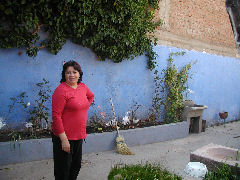
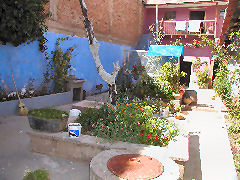
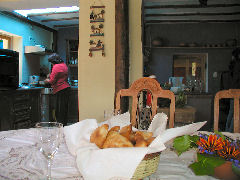
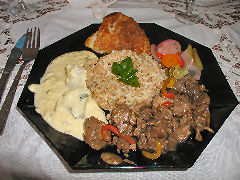
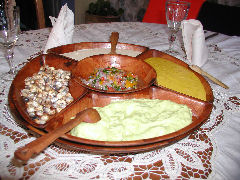
The afternoon, or what was left of it, was spent in a siesta, a bit of wandering and shopping. Then we headed to the Teatro Municipal for an evening beauty contest. Yes, that’s right, the first ever beauty contest for the women of the Altiplano, the area in southern Peru and adjacent Bolivia. Not the sort of competition we’re used to with svelte blonds and brunettes in swimwear talking about how they’ll change the world whenever they get their braces off their teeth. No, these are hard working Aymara and Quechua women, dressed in, first, their every day garb, and second, instead of swimsuits, in the uniform of their village officials. Some were married, some not, most were probably in their late 20s to early 40s. They answered questions that were fired at them in Spanish by the emcee in their indigenous tongue, either Aymara or Quechua – and about 90% of the audience spoke one or the other – we didn’t, so we have no idea what the answers were like, but the cheering said it all. This is the first time I ever applauded at a beauty contest and meant it…
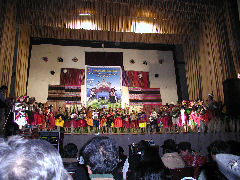
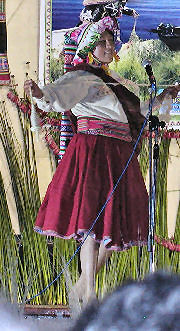
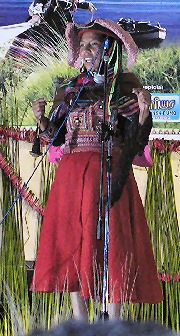
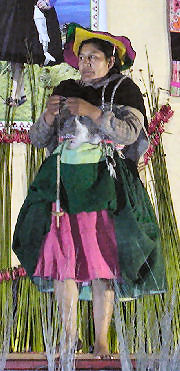
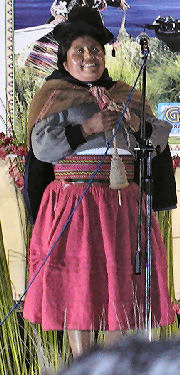
We finished off the evening at the late hour of about 10 p.m., managing to find just one restaurant other than a pizzeria still open, though they were about to close, and they dished us up a couple of more huajsapatas and a couple of bowls of chicken and vegetable soup, not that after our afternoon repast we were up for anything more… Next, up early and off to Cuzco and Machu Picchu.